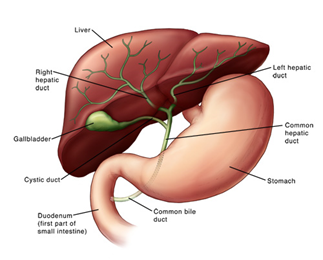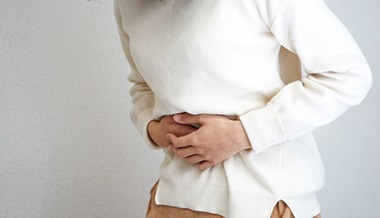Gallbladder Disease
What is gallbladder disease?
Gallbladder disease includes inflammation, infection, stones or blockage of the gallbladder. The gallbladder is a sac located under the liver. It stores and concentrates bile produced in the liver. Bile aids in the digestion of fat and is released from the gallbladder into the upper small intestine in response to food (especially fats). Types of gallbladder disease include:
- Cholecystitis (inflammation of the gallbladder)
- Gallstones
- Chronic acalculous gallbladder disease (in which the natural movements needed to empty the gallbladder do not work well)
- Gangrene or abscesses
- Growths of tissue in the gallbladder
- Congenital defects of the gallbladder
- Sclerosing cholangitis
- Tumors of the gallbladder and bile ducts
Symptoms
The mildest and most common symptom of gallbladder disease is intermittent pain called biliary colic. Typically, a patient experiences a steady gripping or gnawing pain in the upper right abdomen near the rib cage, which can be severe and can radiate to the upper back. Some patients with biliary colic experience the pain behind the breastbone. Nausea or vomiting may occur.
Between 1 percent and 3 percent of people with symptomatic gallstones develop inflammation in the gallbladder (acute cholecystitis), which occurs when stones or sludge block the duct. The symptoms are similar to those of biliary colic but are more persistent and severe. They include pain in the upper right abdomen that is severe and constant and may last for days. Pain frequently increases when drawing a breath. About a third of patients have fever and chills. Nausea and vomiting may occur.
Chronic gallbladder disease involves gallstones and mild inflammation. In such cases, the gallbladder may become scarred and stiff. Symptoms of chronic gallbladder disease include complaints of gas, nausea and abdominal discomfort after meals and chronic diarrhea.
Stones lodged in the common bile duct can cause symptoms that are similar to those produced by stones that lodge in the gallbladder, but they may also cause:
- Jaundice
- Dark urine, lighter stools or both
- Rapid heartbeat and abrupt blood pressure drop
- Fever, chills, nausea and vomiting, with severe pain in the upper right abdomen
Diagnosis
- Blood tests
- Ultrasound and other imaging techniques
Treatment
Surgery may be warranted to remove the gallbladder if the patient has gallstones or the gallbladder is not functioning normally. Most of the time this can be performed either laparoscopically (through small incisions) or with robotic-assisted surgery, both as outpatient procedures.






